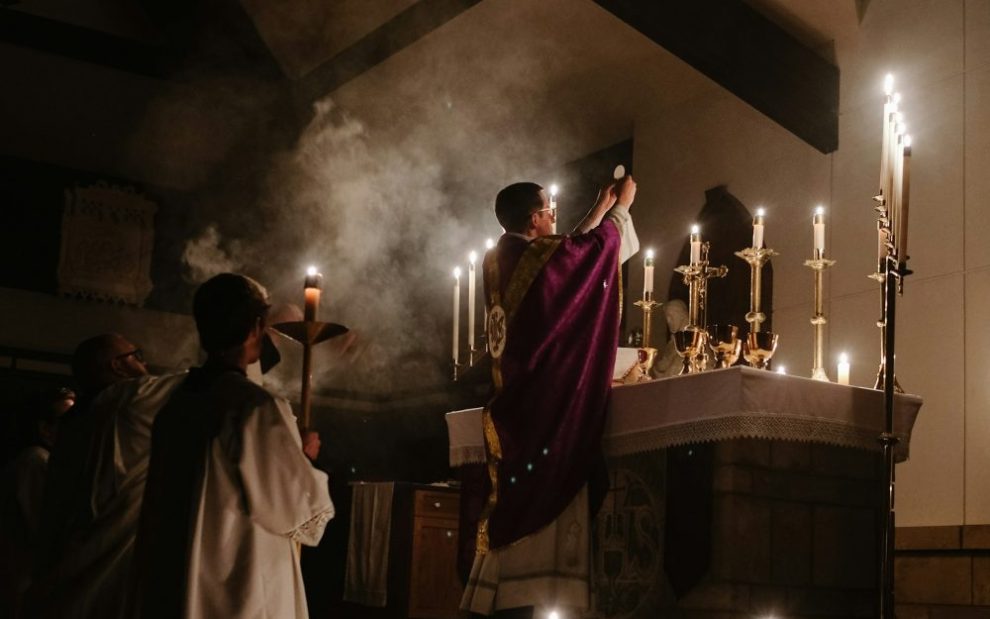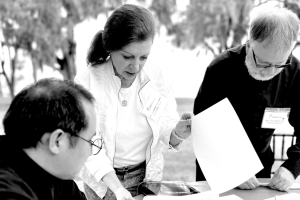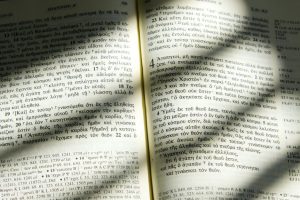In 2016, Lisa Campbell, a Pentecostal convert to Catholicism, began attending religious communities that celebrated the Traditional Latin Mass, sometimes called the Tridentine Mass, the Latin Mass celebrated before the Second Vatican Council. She thought the elaborate, reverent liturgy would deepen her faith. Over time, however, she found these communities focused less on faith and more on exclusion and control. When priests insisted that praying the rosary with anything but unwavering attention was injurious to Mary, Lisa became too anxious to pray the rosary at all. She says her parishes also refused to create programs for older women, dismissing them as prone to gossip and power struggles. One church even turned away a man experiencing homelessness for failing to meet its scrupulous dress code.
When Lisa learned of a priest’s inappropriate entanglement with a female parishioner, she knew she had to leave. But she had absorbed the church’s traditionalist ideologies, including its dislike for the mainstream church. She shared its suspicion of parishes that celebrate the ordinary form of the Mass adopted after Vatican II, the form most Catholics today celebrate.
Lisa continued to pray through her confusion and anxiety. Then one night, she logged on to YouTube and saw a suggested video called “Trad Recovery.”
Recovery from what? she wondered. Her question gave way to a feeling that God was calling her to watch the video. She clicked on it.
Trapped in traditionalism
Catholic traditionalism is a movement that emphasizes the practices, traditions, and liturgies common before Vatican II. It involves more than a preference for celebrating Mass in Latin: It is a movement that rejects Vatican II reforms, including changes to the Mass. Traditionalists see these reforms as a secular corruption of Catholic orthodoxy; they combat them by forming churches that operate independently of the Catholic Church’s hierarchy. Although few in number, these churches are attracting new parishioners, and their strident self-promotion, especially online, has exerted an increasing influence on secular and Catholic culture alike.
Many times, traditionalist Catholics go beyond differences in liturgy. Many also seek a “return” to what they see as traditional teachings on gender roles, sexual identity, and the role of the church in political life. For example, in a review of Patrick Deneen’s book Why Liberalism Failed (Yale University Press) for American Affairs, legal scholar Adrian Vermeule argues that Catholic integralists (those who believe that Catholicism should be the basis of legal thought and policy), should become “elite administrators” who “occupy the commanding heights of the administrative state.”
Despite their growth, some people are leaving traditionalist churches. In an article for National Catholic Reporter, so-called “ex-traditionalists” cited conspiracy theories over whether Pope Francis is actually the pope; bigoted teachings about the roles of women, LGBTQ+ people, and those of other faiths; and political involvement as reasons for leaving their parishes. Some of these ex-traditionalists want to remain Catholic, but they struggle, like Lisa, with religious trauma, misinformation about church teachings and history, and feelings of isolation as they leave their former communities—and sometimes families—behind.
A way out
Trad Recovery, a Montana-based Catholic lay ministry, seeks to address these needs and help ex-traditionalists enter full communion with the church. Founded in February 2023 by Laura Vander Vos, who interviews former Catholic traditionalists on her YouTube channel, Misshappycatholic, and Andrew Minoni, author of the book Altar Against Altar: An Analysis of Catholic Traditionalism (En Route), the ministry operates through a confidential, members-only website, staffed by eight administrators. Site members find counseling services for spiritual abuse, Q&As and blog posts debunking traditionalist propaganda, and public forums where members can build friendships and a sense of community based on their shared experiences. This community is essential to the Trad Recovery process.
Recovery is not a linear process, and it differs for each individual. According to Vander Vos, members typically join the site seeking validation for their conflicted feelings around the present-day Mass and their former churches; as they read fellow members’ stories, they gain validation. “They’re able to put words to the things that they experienced and to be validated in other people experiencing the same things,” Vander Vos says. This usually leads them to become comfortable posting their own stories and questions, whether in the forum or in private messages to particular members.
These online conversations typically lead to in-person participation in the church. Many members have been taught that the Mass we celebrate today is heretical or simply bland and irreverent—but then they see posts that contrast other members’ old preconceptions of the Mass with their positive experiences after attending it. This encourages new members to also attend. If old triggers and fears of damnation arise, members can seek reassurance in the forum. By facilitating friendships between people uniquely suited to understand one another’s difficulties, the ministry helps members recover not only a sense of God’s love and mercy but also trust in their own powers of discernment.
Fear and authoritarianism
Traditionalists often point to the popularity of Latin rite parishes among young people to support the righteousness of their ideology. But most of Trad Recovery’s 500 members are in their 20s and 30s, suggesting that traditionalist churches may be less successful at retaining converts than attracting them. Vander Vos notes that new Catholic converts can be especially susceptible to traditionalism given its promise of a consistent, disciplined form of the faith. But manipulative leaders often twist these sincere motivations into a paralyzing fear of God, far removed from the gospels’ joyful message.
Katherine (who asked that her name be changed to protect her privacy), now a 20-year-old college student in Flagstaff, Arizona, experienced this fear while she was growing up. After her parents divorced, she and her mother relocated from the West Coast to Florida. There, her mother became enamored with the Latin rite. She remarried a fellow traditionalist and raised Katherine in a traditionalist church. The God Katherine encountered in that church was a terrifying one.
From the time Katherine was 8 until she was 17, the constant fear of damnation overshadowed her obsessive prayers over meals and before bed. Before Katherine’s weekly phone calls with her agnostic father, her mother would coach her to encourage him to convert to traditionalism in order to prevent him from going to hell, a belief preached directly from their church’s pulpit. This fear-laden atmosphere, worsened by the church’s belief in an immanent doomsday, caused Katherine to have panic attacks throughout her childhood and teenage years.
Bigotry in traditionalist culture
As a mixed-race woman of Mexican descent on her father’s side, Katherine’s religious trauma went hand-in-hand with misogyny and subtly pervasive racism. “A lot of the spiritual abuse that women particularly have to go through,” Katherine says, “has to deal with . . . always see[ing] yourself through the eyes of whatever man you’re trying to appeal to, whether that’s God, in some cases, or your future spouse.” The community’s leader preached “traditional” gender roles, using scripture to admonish women to obey their husbands. Through homeschooling, parents reinforced the pressure on their daughters to value homemaking over education or career. Of all the girls in the parish Katherine’s age, only one, to her knowledge, pursued any further education.
Katherine says that she felt the predominantly white community also stifled her attempts to connect with her Mexican heritage. One Día de los Muertos, she suggested setting up an ofrenda for a relative who had recently died. Her mother refused, claiming such activities were both demonic and un-American.
Conversations with her father on her visits to his home, combined with discussions with classmates at her private Catholic high school, prompted Katherine to start questioning the church’s teachings. The community’s intense fear and judgment, contrasted with Jesus’ teachings on loving one’s neighbor and joy in the Holy Spirit, only heightened her cognitive dissonance. When she was 17, her mother pressured her to enter a relationship with a 30-year-old man—and Katherine resolved to pursue higher education and leave her religious community behind.
At 18, she moved in with her father. She is now pursuing an undergraduate degree in psychology. Even today, she can’t visit her mother and stepfather without being lectured about returning to their church. She is considering whether it might be necessary to withhold contact with them altogether.
A dysfunctional culture
Gary Campbell, a former priest in the traditionalist Society of St. Pius X (SSPX), now laicized, recalls the rampant prejudice he observed from one of the traditionalist bishops. The bishop frequently and publicly espoused the intellectual inferiority of African Americans, the natural subservience of women, and the existence of a Jewish globalist conspiracy.
In Gary’s view, the frequent prejudice within traditionalism goes hand-in-hand with its tendency to disparage laypeople as morally corrupt and in need of saving by clergy. “The quest for civil rights, decolonization, women’s emancipation, and empowerment of layfolk are all part of the perceived religious corruption of the church,” he says. Religious traditionalism, meant to continuously deepen the church’s understanding of Christian truth throughout time, becomes conflated with the social traditionalism of a particular time and place.
Although such attitudes are disturbing, Gary believes that with no central authority, the traditionalist movement is doomed to fail, degenerating into factionalism. “I have seen it many times,” he says. “Traditionalist turning on traditionalist, because they are not traditional enough. The revolution eats her children.”
But, he admits, the traditionalists constitute an extremely vocal minority, especially online. Some mainstream Catholics are sympathetic to their views. These sympathizers may not go so far as to reject Vatican II, but they are likely to share several traditionalist beliefs: a historically shortsighted view of tradition; an absolutist, conspiratorial worldview; and a legalistic moral theology obsessed with sin and damnation, far removed from the early church’s focus on happiness through virtue.
Traditionalism and trauma
For 23-year-old Cecilia, who requested a pseudonym, traditionalist ideology even outside the Latin Mass community had life-changing consequences. Growing up in a Maronite family in St. Louis with parents she describes as “conservative cafeteria Catholics,” Cecilia was a gifted student, but she struggled with isolation and bullying due to her undiagnosed autism. (It was diagnosed later, when she was 20.) By seventh grade, she had found refuge in the internet. Her interest in her Lebanese heritage led her to research the Maronite Church, which in turn led to deep dives on forums like Catholic Answers.
She developed a hyperfixation on religion. As a 12- and 13-year-old, she carried a copy of the catechism in her backpack, attended confession at least twice a week, prayed the rosary every day, and accompanied her grandparents every weekend to an early morning Mass at her local church. At first, she heard sermons from a priest who seemed to embody the spirit of Vatican II, invoking the love of God and the importance of sharing it with others. But then two new priests arrived at the parish; one of them conducted the Mass in as “traditional” a form as possible, and the other one preached fiery sermons focused on global conspiracies, “evil” Enlightenment ideology, confession, sin, and hell.
The liturgy changes did not bother Cecilia; she finds the Traditional Latin Mass less sensorily overwhelming than typical post-Vatican II Masses. But her church’s preaching about hell, coupled with her exposure to propaganda on traditionalist Discord servers, caused her to view God as a monster.
“I was scared of Christ,” she says. “As a traditionalist, my fear of God wasn’t based on love. It was based on horror. It was based on the constant fear that at any moment, I could drop dead, and because I hadn’t been confessed, I was going to hell, or that even if I didn’t go to hell, I would have to spend a long time in purgatory.”
Her anxiety extended to her parents’ less-than-rigorous religious life. She begged them to go to confession and attend Mass so they wouldn’t be plummeted into hell; she cried herself to sleep at night, blaming herself for failing to save their souls.
“There was one moment, sitting at the lunchroom in middle school,” she says, “and I just thought, I’m going to let myself be an atheist for a second so I can be at peace.” By age 15, her fear of God had become intolerable. She attempted suicide and disavowed religion for the rest of her teenage years.
Different paths
For some former traditionalists such as Katherine, separation from religion is necessary for recovery from traditionalism. Although she respects the faith of her stepsister, a Catholic raised outside of traditionalism by her stepfather’s ex-wife, Katherine’s religious trauma and awareness of the church’s colonial history prevent her from finding comfort in Catholicism. She instead finds meaning in time spent with her sisters and father and in nature.
Other ex-traditionalists retain a desire to remain Christian, even after their traumatic experiences. The Christianity in which they find a home, however, can take many different forms. Cecilia, for instance, rejected the Catholic Church but joined an Episcopal one. While cycling through various shades of atheism and agnosticism, she was drawn to social activism. At the same time, though, she found herself yearning for the devotions and rituals that had once brought her comfort. A conservative Shia Muslim friend with a strong devotion to Mary encouraged Cecilia to reexplore Christianity; when she did, she discovered a wing of the Anglo-Catholic Church called “inclusive orthodoxy,” which marries traditional liturgy with progressive politics.
Today, as a trans woman, Cecilia has found a community of LGBTQ+ Christians who share her love of the rosary, Latin prayers, and sacramental confession. Last year, she attended an Anglican wedding of two women that incorporated such traditional elements as kneeling at the altar. She is currently considering seminary studies, with a focus on ministering to neurodivergent individuals.
Her faith has also become inseparable from social justice causes such as Palestinian liberation. She remarks on the irony that her fellow activists, many of them atheist Marxists, are receptive to her Christian faith, while her former traditionalism only tended to alienate people.
A more moderate traditionalism
Lisa Campbell, meanwhile, has entered into full communion with the Catholic Church and strives to be obedient to church teachings. She cites Bishop Robert Barron’s writings and the online lectures of Franciscan Friar of the Immaculate Father Terrance Chartier as aiding her journey. Trad Recovery also played an instrumental role, she says. She subscribed to the ministry’s website after watching Vander Vos’ YouTube interviews. Cautiously skeptical at first, Lisa was relieved to find she was not alone in her experiences.
When she first returned to a modern-rite parish, the scrupulosity instilled in her by the Institute of Christ the King manifested as resistance and criticism. She refused to follow post-Vatican II additions to the Mass, such as kneeling for the final blessing, or to practice post-Vatican II prayers, such as the luminous mysteries. But through prayer and posting about her difficulties on the Trad Recovery forum, she was able to let go of those negative inner voices. She began to see the externals of worship as means to an end, rather than ends in themselves. Today, she enjoys a sense of peace and easy intimacy with God in her devotions and in the Mass. The frequent prejudice within traditionalism goes hand-in-hand with its tendency to disparage laypeople as morally corrupt and in need of saving by clergy. lighter, and my family and friends have commented on seeing that in me, too. His yoke is easy, and his burden light,” she says.
Lisa has also grown comfortable wearing pants, something forbidden by her former traditionalist priest. When she purchased her first pair, she had nightmares filled with the priest’s scolding, shaming voice. But as she spoke with other women in Trad Recovery—“women wearing pants” is a common topic—those nightmares fell away. Lisa feels confident now in her ability to discern between the church’s authentic teachings and distortions from self-appointed authorities.
With this confidence has come a sense of mission to share her story outside of Trad Recovery. Lisa has spoken of her traditionalist past in interviews with Catholic media outlets such as EWTN, hoping not only to deter potential converts to traditionalism but also to make other Catholics aware of its harmful, schismatic nature.
Public awareness
Trad Recovery, too, aims to raise such awareness. Vander Vos notes that well-intentioned Catholics may minimize or dismiss ex-traditionalists’ experiences due to lack of understanding. “They’ll be like . . . ‘I don’t understand what your problem is . . . I know some people who go to a Latin Mass parish, and they’re some of the best people I know,’ ” she says.
To counter this attitude, the ministry is developing educational resources for laypeople and clergy; it is also planning its second annual in-person Catholics in Communion Conference for July 10–13, 2025, location to be announced. Vander Vos hopes these live conferences, featuring lectures from guest speakers and clergy, can help site members deepen their friendships, while at the same time lending greater visibility to ex-traditionalist struggles within the church.
“They just need the reassurance that God loves you. He wants to give you peace,” she says. “And there’s hope. We’re going to take you by the hand. We’re going to walk with you as long as you need to get to that better place.”
This article also appears in the April 2025 issue of U.S. Catholic (Vol. 90, No. 4, pages 26-30). Click here to subscribe to the magazine.
Image: Unsplash/Josh Applegate













Add comment